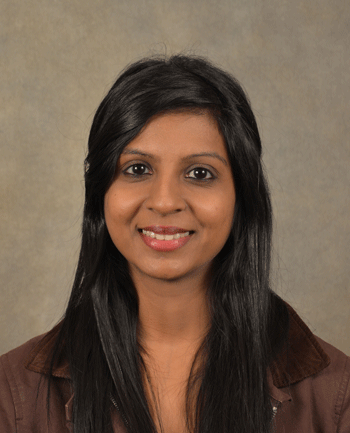Rajula Elango, a postdoctoral fellow at Harvard Medical School, is a rising star in the field of DNA repair and genomic instability.
Her graduate school research contributed to a paradigm shift in the field and she showed that a unique DNA repair pathway, called break-induced replication, has a mode of DNA synthesis that contradicts the accepted understanding that all DNA replication leads to a semi-conservative inheritance of DNA. This important discovery by Elango and her colleagues was published in a leading research journal Nature in 2013.

“When I saw the email that said I was the award winner, I picked up the phone and called my parents,” says Elango. “They were freaking out because it was 1 in the morning in India, but they were so happy and on top of the world.”
Elango's ground-breaking dissertation research at Iowa under the guidance of Dr. Anna Malkova focused on the genetics of DNA repair pathways and on understanding how this pathway may cause reordering of DNA in some cancers.
“During my PhD work, we tried to figure out the exact mechanism of the repair pathway called break-induced replication. I discovered that a lot of things about this pathway are not ideal,” says Elango. “One, we showed that DNA synthesis progresses by a replication bubble intermediate for this pathway. Second, we made the remarkable discovery that break-induced replication repair results in a conservative inheritance of newly synthesized DNA.”
What is already known about DNA damage and cancer is that any sort of damage that your DNA incurs during your lifetime can lead to cancer. And, there's always this very big question—how does DNA damage cause cancer or how does it make cancer worse?
Genetic instability including mutations and chromosomal rearrangements underlies cancer and aging, which makes understanding the mechanism leading to DNA instability very important. Double strand DNA breaks that are accumulated in massive amounts in pre-cancerous cells are the most common source of genetic instability.
“Double strand breaks are one of the most dangerous types of DNA damage and once you break it, the DNA has to make a careful choice on how it can fix itself,” Elango says.
Break-induced replication repairs double strand DNA breaks but leads to deleterious outcomes including mutations and chromosomal rearrangements like those that lead to cancer. This makes it important to understand the mechanism of break-induced replication and to detect its main vulnerabilities.
Elango’s thesis work contributed significantly to understanding the mechanism of break-induced replication and the key molecular players required for it. Understanding this mechanism opens up the possibility to target either the key break-induced replication intermediates and/or the key break-induced replication proteins as a cancer therapeutic.
According to Elango, the best thing about studying DNA damage is that it doesn’t apply to one type of cancer. With that in mind, she is now working with mouse embryonic stem cells—trying to figure out what happens in mammalian cells. Her thought is to utilize bigger model organisms that more closely relate to human beings in lieu of the yeast used in her original research.
“Right now, I'm working with understanding the molecular details of breast and ovarian cancer and I am learning so many things,” Elango says. “As of today, that is, the field that I want to take I want to specialize in breast and ovarian cancer research, considering it has a very strong connection to DNA damage and DNA repair.”
Elango says she loved her time at Iowa and strongly believes that she could not have done it without the support and guidance of her PhD thesis advisor, Dr. Anna Malkova who trained her to be the scientist that she is today. Rajula shared some advice for current and future graduate students.
“I would say there is no alternative to hard work and do what you really, really enjoy,” she says. “You have to look forward to what comes next. You have to come in with the drive and the dedication and Iowa will help you get through that—I can guarantee.”
Almost twenty years into her higher education, it feels like Elango is just getting started. She is thriving at Harvard and hopes to someday run her own cancer-focused laboratory. We look forward to hearing what’s next on her journey.